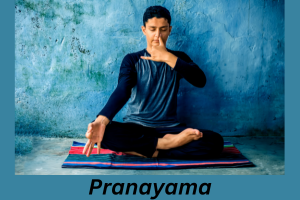Introduction
Pranayama is one of the most vital aspects of yoga that focuses on the regulation and control of the breath.
In Sanskrit, ‘Prana’ means life force or breath, and ‘Yama’ means control or discipline.
Thus, Pranayama refers to the practice of controlling the breath, which is believed to strengthen the connection between the body and mind.

This ancient practice, described in the Yoga Sutras of Patanjali, is considered essential for promoting physical health, mental clarity, and spiritual growth.
Regular practice of Pranayama helps in oxygenating the body, calming the nervous system, and balancing emotions.
Steps to Perform Pranayama Yoga Pose
Pranayama consists of various breathing techniques, each with its own method. Below are steps for performing the most common types of Pranayama:
- Nadi Shodhana (Alternate Nostril Breathing):
- Sit comfortably in a cross-legged position (Sukhasana) with your back straight and shoulders relaxed.
- Place your left hand on your left knee, and use your right thumb to close your right nostril.
- Inhale deeply through the left nostril, then close it with your ring finger.
- Release your thumb from the right nostril and exhale slowly through it.
- Inhale again through the right nostril, then close it with your thumb and release the left nostril to exhale.
- Repeat this cycle for 5 to 10 minutes.
- Kapalabhati (Skull-Shining Breath):
- Sit comfortably with a straight spine.
- Take a deep breath in, then exhale forcefully through the nose by contracting the abdominal muscles.
- The inhalation will happen naturally between exhales.
- Perform 20 to 30 rapid breaths in a single round, then rest for a few breaths.
- Repeat for 3 to 5 rounds.
- Bhramari (Bee Breath):
- Sit in a comfortable position with your eyes closed.
- Inhale deeply, then place your index fingers on your ears to gently block external sounds.
- As you exhale, make a humming sound like a bee.
- Repeat this breath 5 to 10 times, focusing on the vibration created by the sound.
- Ujjayi (Victorious Breath):
- Sit comfortably and take a deep breath through your nose.
- While exhaling, slightly constrict the back of your throat, creating a soft hissing sound.
- Maintain a steady, deep breathing pattern for several minutes.
- Bhastrika (Bellows Breath):
- Sit in a comfortable position.
- Inhale deeply, then exhale rapidly while expanding and contracting your abdomen.
- Perform 10 to 15 breaths in quick succession, followed by a deep inhalation and a slow exhalation.
- Repeat for 3 to 5 rounds.
Benefits of Pranayama Yoga Pose
- Improves Lung Function: Pranayama enhances lung capacity and oxygen intake by focusing on deep and controlled breathing. This can lead to better respiratory function and overall vitality.
- Reduces Stress and Anxiety: By calming the mind and activating the parasympathetic nervous system, Pranayama helps lower stress levels, reduces anxiety, and promotes relaxation.
- Enhances Focus and Mental Clarity: Controlled breathing through Pranayama increases the flow of oxygen to the brain, leading to improved concentration, mental clarity, and cognitive function.
- Balances Emotions: Pranayama regulates the flow of Prana (life energy), which helps in balancing emotions, reducing mood swings, and improving emotional stability.
- Detoxifies the Body: Deep breathing techniques help eliminate toxins from the body, improving digestion and boosting metabolism. It also enhances the functioning of the lymphatic system.
- Increases Energy Levels: Practicing Pranayama regularly revitalizes the body by improving the flow of oxygen, leading to increased energy and reduced fatigue.
- Promotes Better Sleep: Pranayama is known to calm the nervous system, making it an effective practice for those suffering from insomnia or irregular sleep patterns.
- Supports Heart Health: Controlled breathing techniques help reduce blood pressure, improve circulation, and support overall cardiovascular health by calming the heart and reducing stress.
- Boosts Immunity: By improving lung function and increasing the flow of Prana in the body, Pranayama enhances the immune system and prepares the body to fight infections and diseases more effectively.
Precautions and Contraindications for Pranayama Yoga Pose
- High Blood Pressure: Some types of Pranayama, such as Kapalabhati and Bhastrika, involve rapid breathing, which can raise blood pressure. If you have hypertension, consult a healthcare professional before practicing these techniques.
- Heart Conditions: Individuals with heart conditions should practice Pranayama under the supervision of a qualified instructor to avoid overexertion of the heart.
- Asthma or Respiratory Issues: Those with asthma or other respiratory conditions should practice Pranayama with caution. Techniques like Kapalabhati may not be suitable as they involve forceful exhalations.
- Pregnancy: Pregnant women should avoid Pranayama techniques that involve rapid or forceful breathing, such as Bhastrika and Kapalabhati. Gentle techniques like Nadi Shodhana and Ujjayi are generally safer.
- Dizziness or Fainting: If you feel dizzy or lightheaded while practicing Pranayama, stop immediately. This can occur if you’re not used to deep breathing or if you overexert yourself.
- Avoid Overexertion: Beginners should avoid overexertion when practicing Pranayama. It’s important to practice within your comfort level and gradually increase the duration and intensity of the exercises.
- Spinal Issues: Pranayama should be practiced in a comfortable seated position. If you have any spinal issues, ensure that your posture is well-supported to avoid straining your back or neck.
- Timing: This pose is best practiced on an empty stomach, preferably in the early morning or a few hours after eating, to ensure comfort and better control over the breath.
Conclusion
- Pranayama is a deeply transformative practice that connects the body and mind through controlled breathing techniques.
- Regular practice of this pose can lead to enhanced physical health, emotional balance, and mental clarity.
- It not only helps in improving lung function and reducing stress but also acts as a detoxifying agent for the body, boosting immunity and overall vitality.
- This Pose offers immense benefits, it’s important to practice it with caution, especially for individuals with certain health conditions like high blood pressure, heart issues, or respiratory concerns.
- Consulting with a healthcare professional or yoga instructor before beginning is advisable, especially for those new to the practice.
- Incorporating this pose into your daily routine can profoundly impact your physical, mental, and spiritual well-being.
- As you continue to explore and deepen your practice, you will find that it not only rejuvenates your body but also calms your mind, bringing a sense of peace, balance, and inner harmony to your life.
